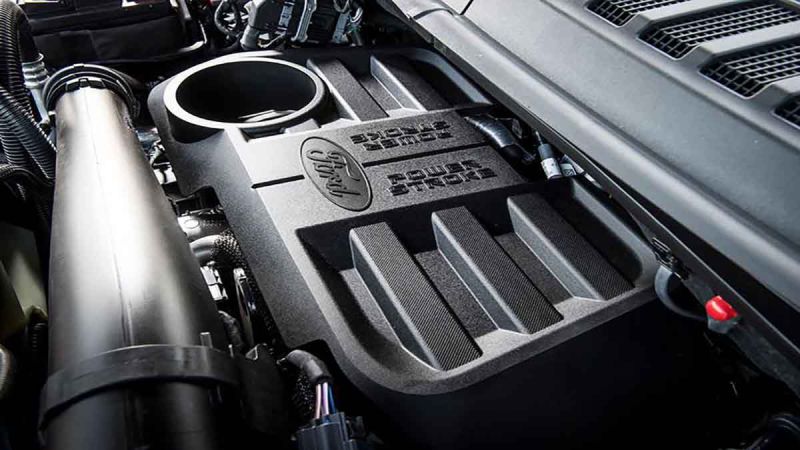I recently wrote about the likelihood that Ford may discontinue the 3.0-liter Power Stroke, after just a couple years of production. The market for this baby Power Stroke has been minimal, it seems amongst Ford truck buyers. On the flip side, Ram has offered their EcoDiesel engine in the Ram 1500 since 2014. In fact, the EcoDiesel is now in its second generation as it debuted in the 2020 Ram 1500.
It seems Ford and Ram are going in opposite direction when it comes to these similar 3.0-liter diesel engines. Ford has found little success with their smaller Power Stroke, while as many as 20 percent of Rams offered come with the EcoDiesel option. So why is that? Let’s look closer at the numbers to see if we can tell why.
Comparing performance of 2020 Ford F-150 with Power Stroke and with EcoDiesel
The 2020 Ford F-150 3.0-liter Power Stroke makes 250 horsepower and 440 pound-feet of torque, which is comparable but a little bit short of the output of the Ram EcoDiesel which makes 260 horsepower and 480 pound-feet of torque. So in this battle of the tape, the Ram edges out the F-150.
Honestly, the impressive torque both engines generate is impressive and is ideal for towing, especially those who tow a long distance.
When it comes to towing, which let’s be honest that’s what matters the most, the Ram 1500 with EcoDiesel leads the way over the Power Stroke F-150. The F-150 has max towing capability of 11,400 pounds, which falls just quite a bit short of the Ram 1500 EcoDiesel which has a max towing rating of 12,560. More than a thousand pounds difference in towing is a big difference to many truck owners.
As far as payload goes, again both trucks are very close, but once again the Ram edges out the F-150 with a payload of 2,040 pounds vs. 2,020 for the F-150.
Ford mates their 10-speed automatic transmission with the 3.0-liter Power Stroke F-150 while Ram offers an 8-speed automatic. Both transmissions are excellent, but with a few more gears, the 10-speed transmission of Ford seems to handle the turbo a little better than the Ram.

Fuel economy for Ram EcoDiesel and Ford F-150 Power Stroke
One of the main reasons consumers might consider the diesel options in their half-ton pickups is the fuel efficiency. And that’s certainly one of the best talking points of both of these engines.
The F-150 with the 3.0-liter Power Stroke has a max EPA rating 22 mpg/city and 30 mpg/highway. Meanwhile the Ram 1500 EcoDiesel has a maximum EPA rating of 22 mpg/city and 32 mpg/highway. When either truck comes with four-wheel drive, their fuel economy ratings are identical. So, once again, it’s practically a wash between these two pickups. My colleague Mary Conway wrote about how one version of the Ram EcoDiesel could get 1,000 miles on one tank of fuel.
Price comparison between Ford F-150 and Ram 1500
To be clear, adding either diesel engine to any truck trim costs several thousand more dollars. For Ford, the 3.0-liter Power Stroke adds about $4000 to the sticker while the EcoDiesel adds nearly $5000 more.
You have to crunch the numbers to see if that increase in price can be offset by the fuel savings. Unless you are towing a lot, over a lot of distance, it may not save you anything. And that’s not to say that some half-ton truck buyers just prefer diesel engines to gasoline ones. That’s certainly their prerogative.
Ford did well to offer the 3.0-liter Power Stroke on more trims instead of just the pricier, upper-tier trims. The F-150 XLT with the 3.0-liter Power Stroke has a starting price of $41,095. Some of my readers commented that many dealers had a lot of inventory for the baby Power Stroke F-150 and that could mean getting these for a lot less.
Conversely, for 2020, the Ram 1500 EcoDiesel has a starting MSRP of $38,585 on a two-wheel drive Quad Cab Tradesman.
Which truck is better? The Ram EcoDiesel or the Ford F-150 Power Stroke
Well, as you can you see the numbers are very close. A slight edge goes to the Ram EcoDiesel and certainly the EcoDiesel is outselling the Power Stroke.
The question is why? The EcoDiesel seems to benefit from promotion and good PR from Ram. Meanwhile, Ford seems to treat the 3.0-liter Power Stroke as an afterthought. Which would make sense why Ford is considering discontinuing this engine after just a couple years.
Sales volume matters and the Ram EcoDiesel dominates the F-150 in that regard. I recently got to drive a Ram 1500 Rebel with the EcoDiesel and it was one of the best trucks I’ve ever driven. The only exception being the 2017 Ford Raptor, which I wrote about being my all-time favorite truck.
The EcoDiesel is quite and confident and seems to be in favor with half-ton truck buyers, while Ford’s 3.0-liter Power Stroke has not been accepted and might be on life support.
I'd love to hear your comments about why Ram seems to be succeeding with the EcoDiesel than Ford is with the 3.0-liter Power Stroke. Leave a comment below.
Jimmy Dinsmore has been an automotive journalist for more than a decade and been a writer since the high school. His Driver’s Side column features new car reviews and runs in several newspapers throughout the country. He is also co-author of the book “Mustang by Design” and “Ford Trucks: A Unique Look at the Technical History of America’s Most Popular Truck”. Also, Jimmy works in the social media marketing world for a Canadian automotive training aid manufacturing company. Follow Jimmy on Facebook, Twitter, at his special Ford F-150 coverage on Twitter and LinkedIn. You can read the most of Jimmy's stories by searching Torque News Ford for daily Ford vehicle report.













Comments
Hi Jimmy,
Permalink
Hi Jimmy,
I currently own a 2018 F150 Lariat Powerstroke. I purchased this as a choice to downsize from an f250 6.7L that was unneeded since we moved from the mountain landscaped west coast to the hilly east coast and a half ton would do the job of towing our camper. I initially wanted an ecoboost but I had a mental dilemma leaving diesel behind. Thats when the sales person pulled the 3.0 around. It solved all my problems related to towing power, smaller truck made for a better family car, and it gets great mileage during my commute to work. I had read about the 3.0L motor but it seemed that no one else did. 90% of people see the POWERSTROKE badge and think I put it on there myself. Once I explain it, everyone seems to love it. I think Fords issue is an educational problem. Its going to be tough for them since they set the bar so high with the Ecoboost motor.
Yes, as I said in the article
Permalink
In reply to Hi Jimmy, by Anthony (not verified)
Yes, as I said in the article, Ford did a lousy job of educating the consumer while it appears Ram did a great job.
What of Ford's 3.5L Eco/PS
Permalink
What of Ford's 3.5L Eco/PS diesel?
That's for Super Duty yes?
Permalink
In reply to What of Ford's 3.5L Eco/PS by Ted huss (not verified)
That's for Super Duty yes? Not for F-150. The 3.5-liter Ecoboost for F-150 is not diesel and is by far the most popular engine for F-150.
Aluminum i have a14 f150 the
Permalink
In reply to That's for Super Duty yes? by Jimmy Dinsmore
Aluminum i have a14 f150 the last year of metal body they keep trying to get me to trade if and when i do i will go to dodge
Why the change? Simply
Permalink
In reply to Aluminum i have a14 f150 the by Rock (not verified)
Why the change? Simply because of aluminum? My hunch is that Ram will shift to aluminum too.
I have a '14 Ram Ecodiesel
Permalink
I have a '14 Ram Ecodiesel and tow a big trailer on a long roadtrip once/mo. It's been terrific. There's some marketing pieces that neither Ram nor Ford has done very well.
Economics. Prospective buyers don't focus on the right things when considering the economics of a diesel. In DD mode, the diesel 1/2 ton mpg is not a big win. Diesel costs more then 87 octane, which most folks put in their truck, That negates the better mpg of the diesel in DD mode. But when towing, diesel engines get far better mpg then gas. This is because they are more efficient at the higher hp that towing requires. My EcoD gets 2x the mpg towing, as a gasser would. The EcoBoost gets particularly bad mpg towing because the engine management riches the mixture to keep the turbo cool.
So marketing depts should be putting towing mpg on the skyline.
Resale value. It costs a lot to get the diesel option in a 1/2 ton. People make the mistake of looking at $$ saved via better mpg and the numbers don't work out that well. But it's important to also take into account the higher resale value of the diesel engine. Thru it's whole life, my EcoD has had a KB value thousands of $$ higher than the Hemi version of the same truck.
Marketing dept's should be talking up resale value of diesel trucks.
Agree it's a marketing issue
Permalink
In reply to I have a '14 Ram Ecodiesel by scott gress (not verified)
Agree it's a marketing issue to some capacity.
Its possible that with fords
Permalink
Its possible that with fords gas powered 3.5 ecoboost engine, the real need to promote the 1/2 ton power stroke just isn't there. The turbo gas generates as much power in torqe as rams diesel at a lower cost and has substantially mort horsepower
I agree with your comment and
Permalink
In reply to Its possible that with fords by Wayne Nelson (not verified)
I agree with your comment and think this is the case.
The dodge gas option doesn’t compare.
Agree that the Ecoboost is so
Permalink
In reply to Its possible that with fords by Wayne Nelson (not verified)
Agree that the Ecoboost is so good it overshadows the baby Power Stroke.
Love my 2019 3.0 Powerstroke.
Permalink
Love my 2019 3.0 Powerstroke. Hanfles all my towing needs on our Ranch . Horses, car trailers etc. Great mileage. Traded in a 2014 Chevy LTZ.
It's rare to switch from
Permalink
In reply to Love my 2019 3.0 Powerstroke. by JOHN U (not verified)
It's rare to switch from Chevy to Ford. Interesting.
As I first read this I’m
Permalink
As I first read this I’m thinking, Ford F-150 hungh with a Diesel??? Maybe a F-250 ( Typo)
Power stroke name belongs to the F250 supper duty and F-350 and so on... but a F-150 that’s not right... then I see Turbo and 250 HP oh well that’s what’s wrong, my 2001 F-250 4x4 has a 7.3 (Navastar) V-8 Diesel with turbo... it’s all stock and I’m the 2nd owner. Mileage is better at 22 city and 30 highway... I’m lucky to maintain 15 mpg average, if I keep it at 62-3 mph on cruise I can hit 21 mpg and that is on a very heavy steel truck with lots of rust I’ll add... As a life long mechanic and traveler to Europe, I have tried to rent diesels when we go to Germany, and nothing is as cool to me as floating along with my family at 143 mph in a 4 cylinder Diesel station wagon and still having 1/4 of the peddle left to mash down and go faster... it was 2016 last time... the cost of fuel for diesel is always cheaper and I like driving a stick over there and always found the gritty-up-n-go... fast torque able to shame most American Cars. And the best part is the really great fuel economy...
Back to the Truck debate now since when is a truck worth as much as a house ??? I can barely swallow the idea that the Ram is the cost of our first house... 26 years ago, and now a $40+k is normal for an entry level pickup... if it is costing us that much our fuel economy should be in the upper 50’s and a 20 year warranty on body rust through should be standard!!! Ford and Chrysler have been in my drive way for many years couple of Japanese imports when I was young and a pair of Used New to us BNW 3 series are now the best cars that we have owned that lifetime mechanic in me is getting old and the repair work on any BMWs compared with any American offering is hands down better!!! My sincere thoughts are that the engineers and the shop mechanics must have both worked together hand in hand on the development of all aspects of anything that needs to be worked on... when American Car / truck companies pull their head out of their third point of contact and start doing this it’s going to be a better world for all... but I’m not going to hold my breath... If BMW made Trucks and they caught on over here more than the Dodge brothers and Ford families would be rolling over in their graves...
I’ve owned a few Plymouth, Dodge, and Chrysler Jeeps too but never a Generous Motors car... but I’ve made money off repairing them a lot... but it is still such a hassle to keep up with all the new tools and computer wiz bang stuff that I’m looking for older cars to fix and drive... a lot less to go wrong with them...
Best regards and thanks for the article...
Thanks for your input
Permalink
In reply to As I first read this I’m by Andrew (not verified)
Thanks for your input
The mileage is not identical
Permalink
The mileage is not identical 30 vs 32 . Two miles per gallon adds up quite fast , especially if your going to have that truck for 10 yrs .
I would buy the diesel if it
Permalink
I would buy the diesel if it matched or was closer to the max trailer tow ratings. It is odd that the ratings don't match. I agree with the other writer above, the manufacturers really miss important points like mpg while towing, oil consumption expectations, overall durability/life of the engine and resale value of the truck. A commercial diesel engine is very durable. How close can these automotive diesels compare? We know a long life is possible in a commercial diesel.
How long something will last
Permalink
In reply to I would buy the diesel if it by David Oren (not verified)
How long something will last is what I get asked all the time. I wish I had that answer.
I bought an 18 F-150 diesel.
Permalink
I bought an 18 F-150 diesel. It's amazing. What is wrong with Ford marketing? I paired it with a 5500 lbs loaded 25 travel trailer. Combination is beautiful. I get 14 to 16 mpg towing 60 mph. Even higher on county roads with lower speed limits. 60 mph the truck turns around 1500 rpm in 10th. Drops to 8 on moderate hills. Super quiet. Wife loves it. I use equalizer hitch, zero sway issues. No one talks about it but the mechanical fan results in some parasitic loss but it keeps the temperatures solidly consistent.
I'm considering both Ford F
Permalink
I'm considering both Ford F-150 and the RAM Rebel. My concern with the RAM is the engine is from Italy? Who makes this engine and are parts going to be an issue down the line?